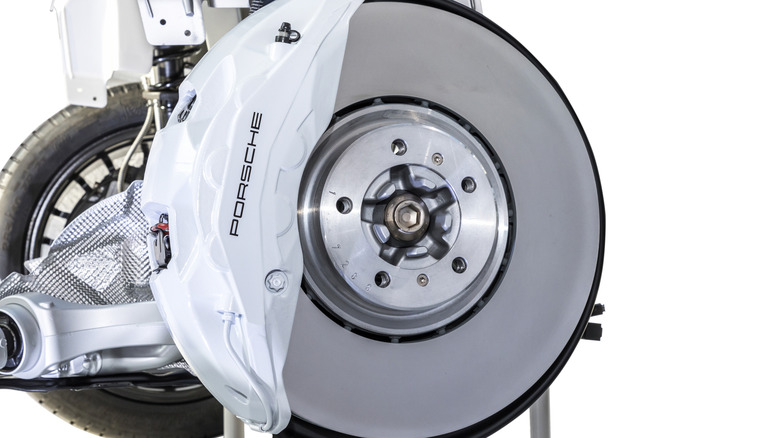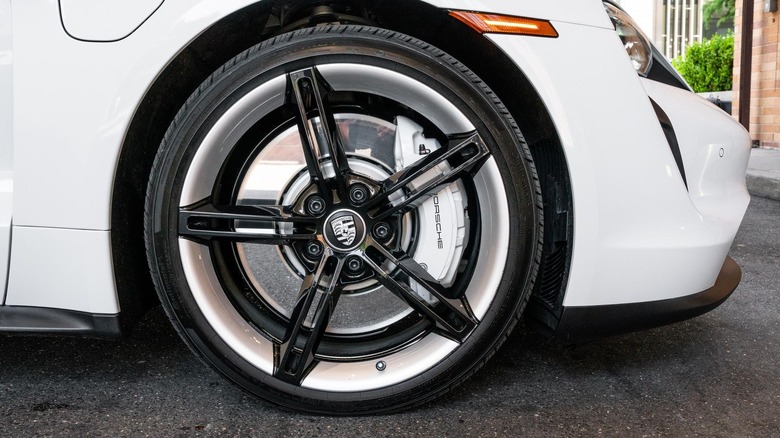
For the discerning Porsche owner, the journey doesn't begin with the roar of a flat-six — it starts with the quiet, contemplative click of a configurator. It's a labyrinth of choice, basically a personality test on wheels. Companies blow thousands on Myers-Briggs personality tests, but I'd argue you learn more about someone from how they spec their hypothetical Porsche.
Buried deep in the maze of leather-this and carbon-fiber-that comes a decision that stops you in your tracks: the brakes. This isn't
just about stopping, it's about the crossroads of performance and your bank account. Porsche gives you a trio to choose from on most models. First, there's the tried-and-true cast iron setup, standard on most lower-end models and effective. Then there's the elite Porsche Ceramic Composite Brake (PCCB), which have signature yellow calipers and cost about as much to replace as a decent used Boxster.
Now for the Goldilocks option: Porsche's Surface Coated Brake (PSCB), which debuted on the third-generation Cayenne in 2017 and is now found on various other models. It's the middle child with a tungsten-carbide twist. Identifiable by its gleaming white calipers and shiny rotors, PSCB promises ceramic-like perks of reduced dust and no rotor rust without forcing you to auction off internal organs. It seems like the perfect compromise. But as we know, there are no free lunches — especially in performance.
Read more: Everrati's Electric Porsche 911 RSR Has Me Driving Into The Future With Open Arms
What Happens When Porsche Engineers A Compromise?

So what exactly is this magical middle-ground that promises the world? The Surface Coated Brakes aren't some unobtainium alloy from a distant galaxy — it's simply an evolution of boring, old tech. First, it starts life out as a regular cast-iron rotor. Porsche, with an assist from Bosch, laser-etches the rotor's face, giving it a texture and structure for the next step. Then comes a galvanic interlayer, a flexible bond designed to keep the next layer from cracking off from heat. It's the only thing standing between cutting-edge braking tech and your fancy tungsten flaking off like a burnt croissant.
Then the real genius begins: a process called High-Velocity Oxy-Fuel (HVOF) spraying blasts tungsten carbide particles onto the disc at supersonic speeds. The result? A mirror-slick, 100-micron-thick coating that's about the thickness of a grain of table salt yet ten times harder than iron. Too hard, in fact, for regular pads.
Porsche then teamed up with Akebono to cook up a proprietary compound that can actually grip the ultra-hard surface. That means PSCBs are a closed system; there's no swapping pads or rotors for non-PSCB specs, and no aftermarket options at the time of this article. Porsche is known for sweating the engineering details, but going this hard just to land in the middle feels either commendable or a bit unhinged.
The Not-Quite-Ceramic Brakes Seem Too Good To Be True?
PSCB promises to split the difference between dusty old iron and the eye-watering cost of carbon-ceramics. You get gleaming white calipers, minimal brake dust, and rust-resistant rotors, all for a relatively tame $3,620 option price on a 2025 Taycan. Compared to the $9,780 charge for carbon-ceramic brakes, PSCB feels almost reasonable. But in Porscheland, "middle ground" still can mean premium pain down the road. A full PSCB brake job can run over $10,000 at the dealer, more than triple what iron brakes cost to service.
The kicker: Porsche says PSCB rotors last 30% longer than iron, but that longevity isn't guaranteed either. Owners have reported the coating chipping, cracking, or delaminating by 40,000 to 55,000 miles — a failure that turns your fancy rotor into what you paid to replace in the first place. Some owners claim their dealers covered the first failure, citing a technical service bulletin posted by Porsche for squeaking PSCB brakes. Second or third? Good luck.
In a previous article, we came to the conclusion that big brake kits are worth the splurge. For many buyers, PSCB delivers that sweet spot of cleaner wheels and better performance without going full ceramic. But it's not the slam-dunk it first appears to be. Had PSCB debuted first, Porsche owners would've rioted over $10,000 brake jobs. But carbon-ceramics set the bar so sky-high, this tungsten-coated middle child somehow feels like a bargain — which is exactly how they get you.
Want more like this? Join the Jalopnik newsletter to get the latest auto news sent straight to your inbox...
Read the original article on Jalopnik.











